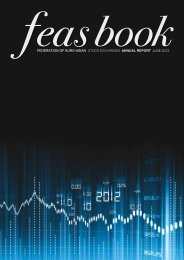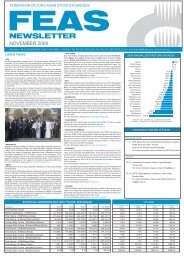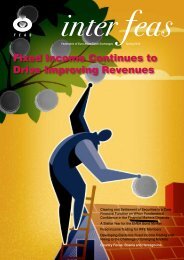Download - FEAS
Download - FEAS
Download - FEAS
Create successful ePaper yourself
Turn your PDF publications into a flip-book with our unique Google optimized e-Paper software.
FEDERATION OF EURO-ASIAN STOCK EXCHANGES ANNUAL REPORT APRIL 2011<br />
Types of market manipulation<br />
• Front Running: The practice of a broker<br />
trading ahead of an order for a client positions<br />
the broker to benefit from the price movement<br />
caused by the client order. In a fragmented<br />
market a broker’s order can be executed on<br />
one trading venue and the client’s order<br />
executed on another, making it impossible to<br />
see the connection at the exchange level.<br />
Considered in isolation, there is nothing wrong<br />
with these trades. Effective surveillance must<br />
be carried out by a team with access to the<br />
consolidated, broker identified, principal<br />
agency tagged trading data across venues.<br />
• Bait and Switch: In this scenario a market<br />
participant tries to achieve a better price by<br />
convincing other investors that there is a large<br />
aggressive buyer (seller) active in a company,<br />
when in fact the same investor is actually<br />
selling (buying). In a multiple venue setting,<br />
the two parts of the manipulative strategy can<br />
be split across two venues. For example, the<br />
large buying bait order may be placed on the<br />
market that has the most liquidity and the least<br />
risk of execution, while the owner of the bait<br />
order is selling the same security on another<br />
venue. Isolated surveillance is blind to this<br />
activity.<br />
• Dark Pool Gaming: Dark pools don’t<br />
provide any pre-trade transparency so<br />
investors don’t know the best bid or offer<br />
(BBO). In the U.S. and Europe dark pools are<br />
restricted to executing trades within or at the<br />
consolidated or primary listing BBO. Dark<br />
pools can be gamed by placing orders onto<br />
the lit books that narrow or move the reference<br />
BBO. Buyers who want to trade in the dark<br />
may place sell orders onto the primary market<br />
to reduce the reference sell price. Those<br />
orders need only be for a small number of<br />
shares, enough to register as the best BBO,<br />
making this a low cost strategy to significantly<br />
change the overall trade value of a large block<br />
in the dark. We have advised customers to<br />
deploy alerts that look for small trades in the<br />
dark, which test for liquidity, followed by a<br />
change in the spread on the lit book and then<br />
a large trade on the dark book. This pattern<br />
may indicate that a broker is moving prices on<br />
the lit book to improve its executions on the<br />
dark book. To identify this, the dark pool<br />
needs to have knowledge of the lit book BBO.<br />
• Taking Advantage of Market Open<br />
Differences: This type of market manipulation<br />
takes advantage of the same security trading<br />
on markets with different open times and<br />
where the closed market is primary. A large<br />
order is placed into the opening auction on<br />
the primary market, which although closed<br />
can still signal to the open markets that a price<br />
adjustment is necessary. Theoretically, a trader<br />
wanting to sell at a high price could place a<br />
large buy order at a very high price into the<br />
pre-open on the primary market and hope that<br />
the open markets’ prices react. There is no<br />
risk of the buy order being executed since it<br />
was placed on a closed market. To spot this<br />
activity, the non-primary markets will need to<br />
have the indicative opening prices on the<br />
primary markets fed into their surveillance<br />
system. Alternatively, the regulatory agent<br />
would need to have full order book<br />
surveillance of all markets.<br />
• Trading halts: Market operators commonly<br />
respond to high volatility in a single security by<br />
halting trading in a stock and issuing a price<br />
query to the listed company. This allows the<br />
market participants to assimilate any newly<br />
disclosed information and allows price<br />
discovery to occur through a call auction. In<br />
some cases alternative markets ignore the halt<br />
and continue trading, allowing participants<br />
with unfair access to information to trade<br />
before the primary market re-opens.<br />
Regulators need to ensure that a uniform<br />
process is followed by all trading venues<br />
based on a clear halting framework.<br />
CONTACT INFORMATION<br />
Contact Name Mr. Henri Bergström E-mail henri.bergstrom@nasdaqomx.com Website www.nasdaqomx.com<br />
PAGE 19
















